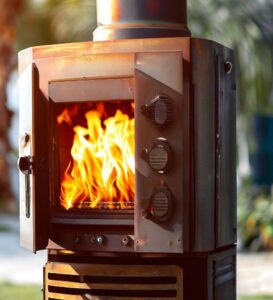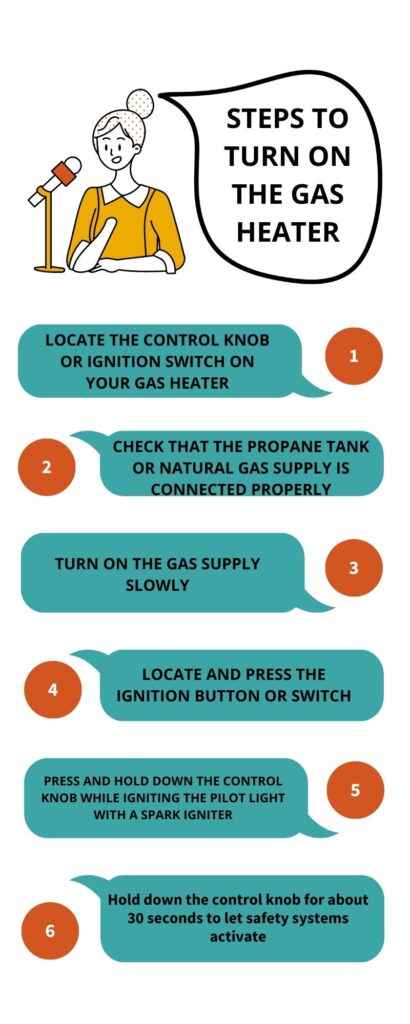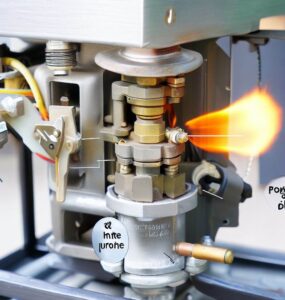Table of Contents
Gas heaters are a great way to keep warm outdoors. To safely turn on your gas heater, make sure you have a propane or natural gas supply.
Key Steps
- Find the control knob near the fuel tank and turn it to the “Off” position. Wait five minutes to let any gas dissipate.
- Afterward, flip the knob to “Pilot” and press down while pushing the piezo igniter button. You’ll hear a clicking sound as the igniter sparks.
- Keep holding down the knob for 30 seconds to heat up the thermocouple. Ensure the pilot flame is steady, then switch to the desired heat setting.
Ventilation is key when using gas heaters outside. Place it in an open area and check all components for wear and tear. Also, check for leaks with a soapy water test.

My friend Sam didn’t read the manual and almost caused an accident. Flames shot out from the heater! We managed to put it out and learned a valuable lesson about safety.
To get the most out of your gas heater, read the instructions and abide by safety guidelines. Enjoy the warmth and stay safe!
Steps to turn on the gas heater
Turning on a gas heater can be intimidating. But, with the correct steps, it’s simple! Here’s the lowdown on how to safely get your outdoor gas heater up and running:
- Locate the control knob or ignition switch on your gas heater. It’ll usually be in the front or top of the unit. Make sure it’s in the ‘off’ position.
- Check that the propane tank or natural gas supply is connected properly. Test for leaks using a soapy water solution – any bubbles mean tighten those connections!
- Turn on the gas supply slowly and carefully.
- Locate and press the ignition button or switch.
- Press and hold down the control knob while igniting the pilot light with a spark igniter. You may need to do this more than once until you see a steady flame.
- Hold down the control knob for about 30 seconds to let safety systems activate. Then, release and turn the knob counterclockwise to adjust the flames according to your desired heat level.

Be sure to read your owner’s manual for any special instructions for your specific gas heater model. Also, safety first!
Safety precautions and tips regarding Gas Heater
As an expert in gas heaters, I’m aware of the importance of safety. Here are some essential tips to keep in mind:
- Ensure all components are working: Check the regulator, delivery pipe, and control valve for any leaks or damage before turning the heater on.
- Read the manual: Each model may have unique instructions for safe usage. Be sure to read the owner’s manual thoroughly.
- Keep a safe distance: Keep 3 feet between the heater and any flammable materials.
- Check for a tilt switch: Some models come with one that automatically shuts the heater off if tipped over.
- Use in a well-ventilated area: Gas heaters produce carbon monoxide, so use in open spaces with good air flow.
- Use a bug screen: A mesh screen prevents insects or debris from entering the burner area.
Remember to turn off the patio heater when not in use and don’t leave it unattended. Now you can safely enjoy your outdoor space!
Pro Tip: Periodically inspect and clean the igniter to avoid dirt and debris build-up. A clean igniter will ensure reliable ignition. Stay safe and warm – don’t let your gas heater turn your gathering into a hotdog roast!
Understanding the gas heater components
Gas heaters are complex. They have many components that work together to generate heat in outdoor spaces. Check out this table for key elements and their functions:
| Component | Function |
|---|---|
| Burner | Creates a flame which makes heat |
| Pilot Ignition | Makes a spark to light the pilot light |
| Gas Control Valve | Regulates the flow of gas to control the heat |
| Igniter | Helps start the ignition process with a spark |
| Thermocouple | Measures the temperature and keeps the gas valve open |
| Regulator | Controls the pressure of gas flowing into the heater |
| Piezo Igniter | Gives automatic ignition without needing a match |
Plus, there are other parts like the gas delivery pipe, propane tank, ignitor button, and thumb wheel control knob that are important for safety and proper functioning. Each gas heater is different, so look at your heater’s owner’s manual for instructions.

Pro Tip: Inspect and clean your gas heater’s components regularly for better efficiency and longer life. Get ready to embrace the great outdoors with your gas heater – winter is coming!
Preparing for gas heater operation
- Check the gas supply:
- Ensure you have enough propane or natural gas.
- Connect the tank to the delivery pipe securely.
- Inspect the components:
- Examine the heater for any damage, such as leaks or loose connections.
- Make sure the igniter, pilot ignition system, and burner are functioning properly.
- Clear the area:
- Before using the gas heater, make sure there are no flammable materials or objects nearby.
- Keep away from walls, furniture, and anything else that could be affected by heat.
Remember:
- Read and follow the manufacturer’s instructions to ensure proper installation and use of your outdoor gas heater.
Follow these steps to get your gas heater going and enjoy the warmth without any worries!
Frequently Asked Questions
1. How do I turn on a gas heater outdoor?
Answer: To turn on a gas heater outdoor, follow these steps: – Ensure the gas tank is connected and turned on. – Locate the control knob on the gas control valve and turn it to the “Pilot” position. – Press and hold the control knob down, then press the igniter button to light the pilot. – Continue holding the control knob for about 30 seconds after the pilot is lit. – Release the control knob and turn it to the desired heat setting. – The gas heater should now start producing heat.
2. How do I turn off a gas patio heater?
Answer: To turn off a gas patio heater, follow these steps: – Locate the gas control valve and find the control knob. – Turn the control knob to the “Off” position. – This will shut off the gas supply and extinguish the flame, turning off the heater.
3. What is a pilot ignition system on a gas heater?
Answer: A pilot ignition system on a gas heater is a feature that uses a small, continuously burning flame (known as the pilot light) to ignite the main burner when heat is needed. It ensures that the heater can be easily and quickly lit when desired.
4. What is a gas control valve?
Answer: A gas control valve is a component of a gas heater that controls the flow of gas from the propane tank or natural gas supply to the burner. It typically includes a control knob to adjust the heat output and may also have additional safety features such as an automatic ignition system and a tilt switch.
5. How often should I inspect the gas components of my outdoor gas heater?
Answer: It is important to regularly inspect the gas components of your outdoor gas heater to ensure their proper functioning and safety. It is recommended to conduct a thorough inspection at least once a year or before the start of each heating season. This includes checking for any gas leaks, verifying the connections, and cleaning any debris or blockages in the burner or ignition system.
6. Is it safe to use a gas heater outdoor?
Answer: When used properly and following safety instructions, gas heaters can be safe for outdoor use. However, it is important to ensure proper ventilation, keep flammable materials away from the heater, and regularly inspect for any gas leaks or malfunctions. Additionally, it is advisable to never leave the gas heater unattended and to turn it off when not in use.
Conclusion
Gas heaters are a trusty source of heat for outdoors. Follow these easy steps to turn it on:
- Locate the control knob.
- Turn the control knob to “Pilot”.
- Press and hold the control knob while pushing the igniter button.
- If you hear a spark, continue to hold the control knob for 30 seconds.
- After 30 seconds, switch the control knob to “On”.
The ignition feature means you don’t need to light the pilot flame!
Before use, check for any damage or gas leaks. It’s important to ensure proper ventilation as carbon monoxide can be produced during combustion. Enjoy the warmth of your heater!
